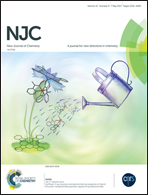Controllable TiO2 heterostructure with carbon hybrid materials for enhanced photoelectrochemical performance
Abstract
In TiO2 both advantages (stability and low cost) and disadvantages (large bandgap) coexist, so how to optimize a bare TiO2 electrode is a continuous hot topic for the construction of suitable photoelectrochemical (PEC) devices based on TiO2 for water splitting. This paper reports a facile and simple fabrication of a TiO2/RGO/C3N4 photoelectrode for PEC splitting of water. Its heterostructure configuration has been characterized and confirmed by XRD, Raman spectroscopy, XPS, TEM and STEM. The introduction of both RGO and C3N4 film onto the surface of TiO2 is mainly due to the fact that C3N4 has a strong photoelectric ability to respond to visible light and RGO plays an important role in the fast transfer of photogenerated charges across interfaces. Photocurrent and monochromatic incident photon-to-photocurrent efficiency (IPCE) of the titled heterostructure have been obviously improved, and the IPCE value (0.5 V vs. AgCl/Ag) of TiO2/RGO/C3N4 was estimated to be up to 28% at a wavelength of 400 nm.



 Please wait while we load your content...
Please wait while we load your content...